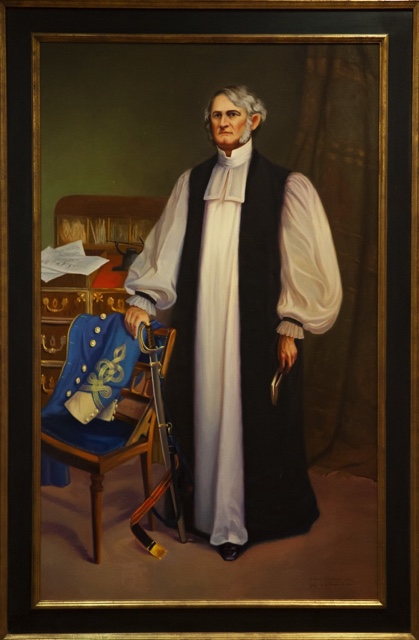Removed Portraits: Sword Over the Gown

Eliphalet Frazer Andrews, “Sword Over Gown”
Leonidas Polk, first Episcopal Bishop of Louisiana, was principal founder of The University of the South and its first chancellor. Born in Raleigh, N.C., in 1806, he underwent a religious conversion experience while studying at West Point and entered the priesthood in 1830. This was the start of his journey that led him to Sewanee. He more than a priest; over the course of his life, he owned large plantations in Tennessee, Louisiana, and Mississippi and enslaved hundreds of people. In 1838 he became a “Missionary Bishop of Arkansas and the Indian Territory” and in 1841 Bishop of Louisiana. Without resigning his church leadership, he joined the Confederate Army as a Major General in 1861 and was known thereafter as “The Fighting Bishop.” He was killed in battle in Georgia in 1864.
The Funding and Creation
In 1893, Kentucky’s Lt. Gov. John C. Underwood, a Confederate veteran, headed the effort to memorialize 6,000 Confederate soldiers who died in Chicago. The “Confederate Mound” memorial was so successful that he was named to create a similar memorial in Richmond. Underwood, who commissioned Eliphalet F. Andrews, the director of the Corcoran School of Art, to paint a number of oil-based portraits of Confederate leaders, one of which, was “Sword over the Gown.” These portraits were unveiled in 1900 during the reunion of the United Confederate Veterans in Louisville, Ky. Andrews concocted a fictional scene for his representation of Polk, wearing his clerical garments and his hand placed on his Confederate uniform and sword, which rested on a chair. The pose was taken from a carte de visite photograph of Polk that had been made taken by the Mathew Brady studio prior to outbreak of the war.
The Traveling Portrait
After its 1900 unveiling, the portrait was not sent to Battle Abbey (home of Confederate Memorial Association in Richmond, Virginia) as Underwood intended because of insufficient funding to finish construction of the building. It was stored away until 1910, when the Rev. James D. Gibson bought it for $361; he sold it to Sewanee’s Vice-Chancellor Benjamin F. Finney in 1927. It hung in St. Luke’s School of Theology until 1948, when it was moved to Sewanee’s library in Convocation Hall. In 1998 local teenagers sprayed fire extinguishers on the hall’s historic portraits, including “Sword Over the Gown.” Moved to the basement to await restoration, it sustained devastating water damage from a burst pipe. A Sewanee alumnus from the class of 1984, who was especially desirous that the University would cherish Polk’s memory, commissioned Nashville artist Connie Erickson to paint a reconstruction in 2003. The reproduction hung in Convocation Hall until University officials moved it to the archives in 2019. They explained at the time that only “historic” portraits contemporary with the University’s founding, would be displayed in Convocation Hall. The original damaged portrait moved to the archives, and the University loaned the copy to the National Confederate Museum in Columbia, Tennessee, where it was prominently displayed until 2023. The University requested its return, and the painting arrived back in Sewanee in June 2023. It is now stored out of view in the William F. Laurie University Archives and Special Collections.
